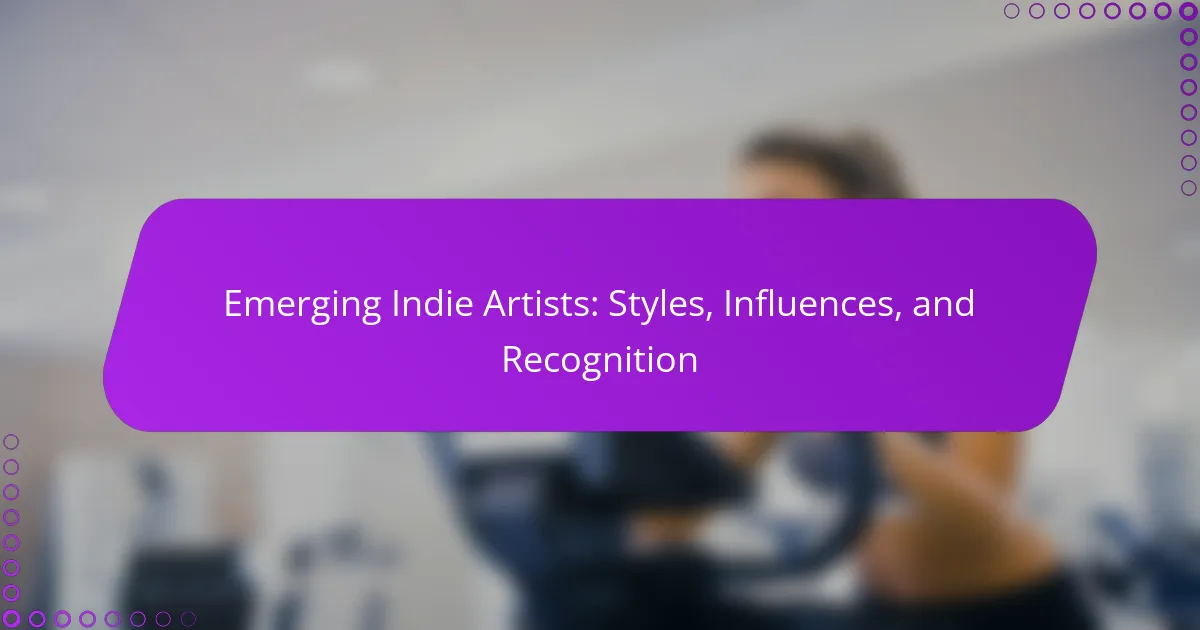Emerging indie artists are reshaping the music landscape with their unique styles and diverse influences. They navigate challenges in gaining recognition while leveraging social media and streaming platforms for exposure. Cultural and regional elements inform their sound, enhancing their distinctiveness. Collaborations within the industry further expand their reach and visibility, driving innovation in the indie music scene.
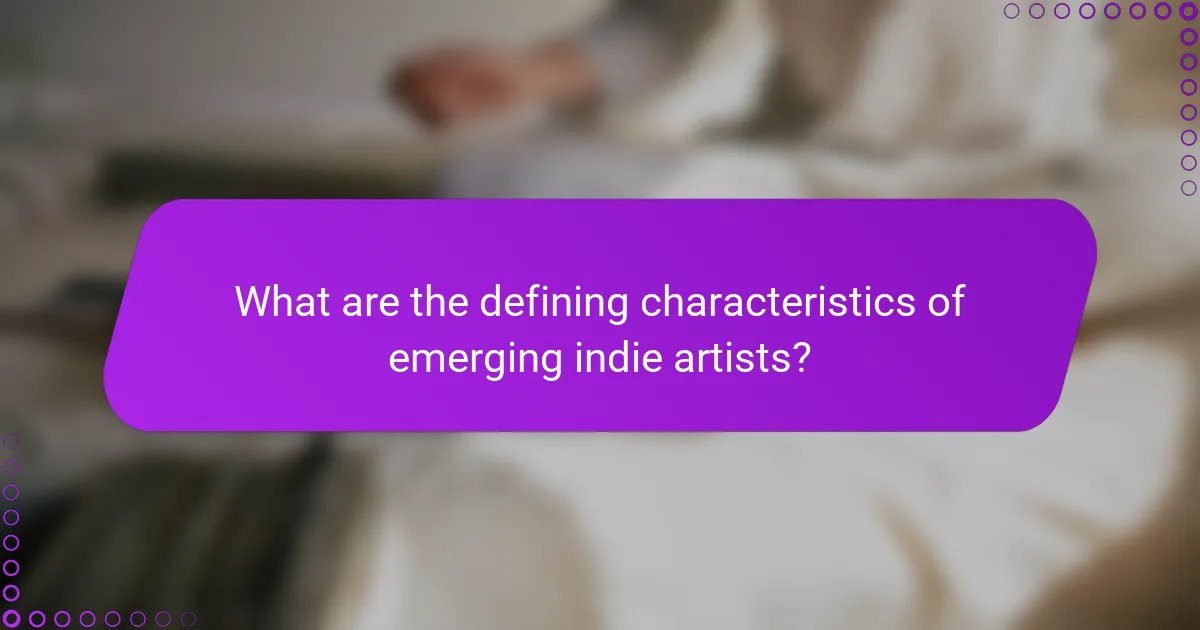
What are the defining characteristics of emerging indie artists?
Emerging indie artists are characterized by their unique styles, diverse influences, and increasing recognition within the music industry. They often blend genres, drawing inspiration from various musical traditions, which results in innovative soundscapes. Additionally, these artists frequently leverage social media for exposure, allowing them to build dedicated fanbases independently. Their recognition often stems from grassroots movements, live performances, and the support of niche music communities.
How do musical styles influence the identity of indie artists?
Musical styles significantly shape the identity of indie artists by influencing their sound, image, and audience connection. Diverse genres allow artists to express individuality and explore personal narratives. For instance, blending folk with electronic elements can create unique soundscapes, setting an artist apart. This stylistic freedom fosters authenticity, which resonates with audiences seeking genuine connections. Additionally, music influences perceptions of the artist’s brand, impacting marketing and recognition within the industry. Ultimately, the interplay between musical style and identity is crucial for emerging indie artists navigating their careers.
What role do lyrics and themes play in indie music?
Lyrics and themes are central to indie music, shaping its emotional depth and storytelling. Emerging indie artists often explore personal and societal issues, allowing for unique expression. These elements resonate with audiences, fostering connection and recognition. Themes like love, identity, and social justice frequently emerge, reflecting the artists’ influences and experiences. The authenticity found in lyrics differentiates indie music from mainstream genres, creating a distinct and relatable sound.
Which instruments and production techniques are commonly used?
Emerging indie artists commonly utilize a mix of traditional and modern instruments alongside innovative production techniques. Instruments such as guitars, keyboards, and drums are staples, often combined with digital software for recording and mixing.
Production techniques include layering, sampling, and the use of effects like reverb and delay. Many artists also experiment with lo-fi aesthetics to create unique soundscapes. This blend of instruments and techniques fosters diverse musical styles, contributing to the distinct identity of emerging indie artists.
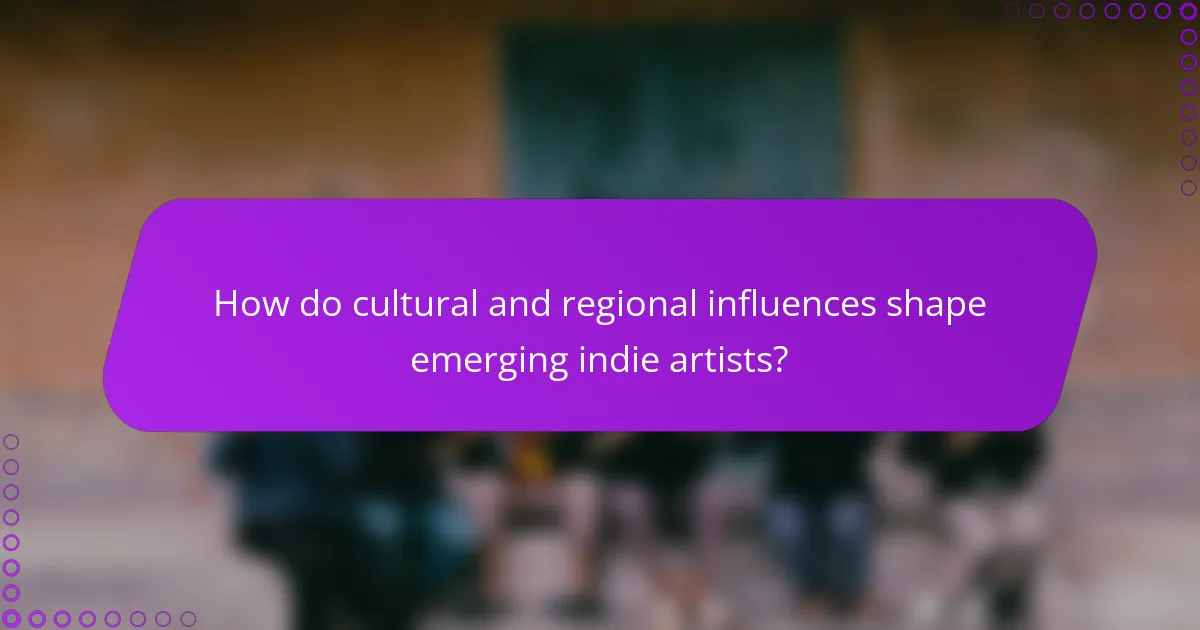
How do cultural and regional influences shape emerging indie artists?
Cultural and regional influences significantly shape emerging indie artists by informing their musical styles and themes. Local traditions, languages, and societal issues inspire their lyrics and sound, creating unique expressions. For instance, artists from diverse backgrounds incorporate local instruments and genres, enriching the indie music landscape. Additionally, regional music scenes foster collaboration and innovation, helping artists gain recognition beyond their immediate environments. This blend of cultural heritage and contemporary influences distinguishes emerging indie artists in a global market.
What impact does local music scene have on artist development?
The local music scene significantly influences artist development by providing opportunities for exposure, collaboration, and feedback. Emerging indie artists often thrive in vibrant local environments, where they can connect with audiences and other musicians. This interaction fosters unique styles and influences that shape their music. Additionally, local venues and events offer platforms for recognition, helping artists build a following. As a result, the local music scene acts as a catalyst for creative growth and career advancement.
How do social and political contexts influence their music?
Social and political contexts significantly shape emerging indie artists’ music by influencing themes and styles. Artists often draw inspiration from current events, societal issues, and cultural movements. For instance, political unrest may lead to protest songs, while social movements can inspire messages of unity and change.
The unique attributes of indie music allow artists to express personal experiences and societal observations authentically. This genre often embraces diverse influences, reflecting the multicultural dynamics of contemporary society. As a result, emerging indie artists gain recognition not only for their sound but also for their relevance to pressing social and political conversations.
In summary, the interplay between social and political contexts enriches the narratives within indie music, fostering a deeper connection with audiences.
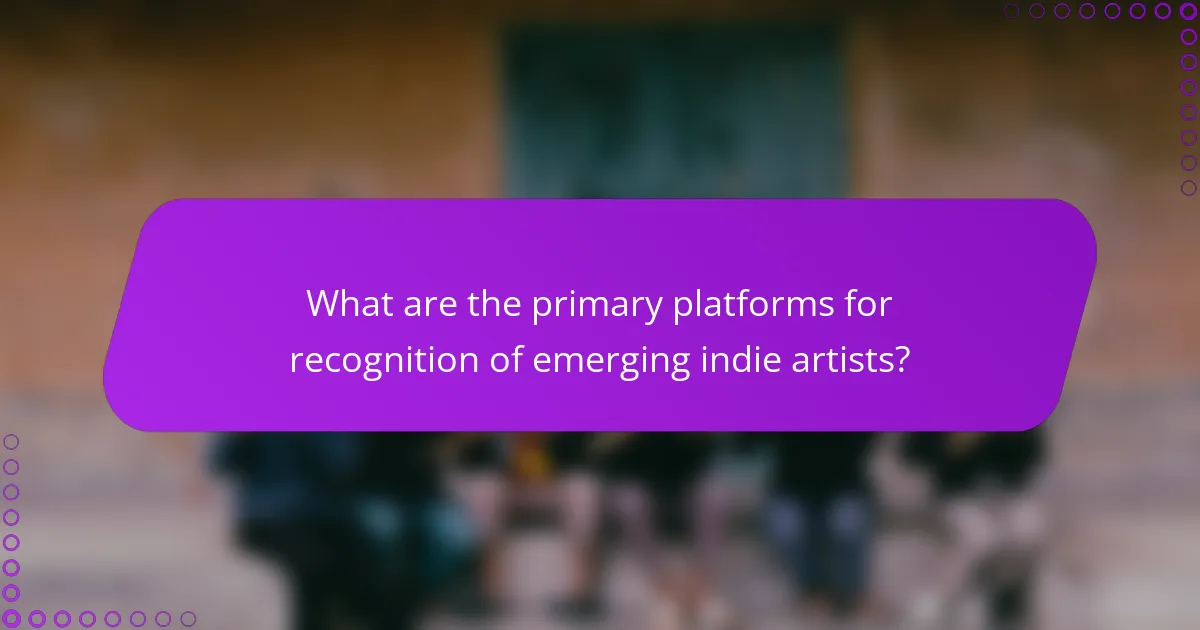
What are the primary platforms for recognition of emerging indie artists?
Emerging indie artists gain recognition primarily through social media platforms, streaming services, and music festivals. These platforms facilitate exposure and audience engagement.
Social media platforms like Instagram and TikTok allow artists to showcase their work and connect directly with fans. Streaming services such as Spotify and Apple Music provide playlists that promote new indie music. Music festivals often feature emerging artists, offering them a stage to reach wider audiences.
Additionally, platforms like Bandcamp allow indie artists to sell music directly to fans, enhancing their visibility and revenue. Online communities and forums also play a role in supporting and promoting new talent.
Which streaming services are most popular among indie artists?
Spotify, Apple Music, and Bandcamp are the most popular streaming services among indie artists. These platforms provide significant exposure and unique features tailored for independent musicians.
Spotify offers curated playlists that enhance visibility, while Apple Music provides robust analytics for artists. Bandcamp stands out with its direct-to-fan sales model, allowing artists to retain more revenue.
Emerging indie artists often choose these services for their accessibility and promotional tools. Each platform caters to different needs, making them essential for gaining recognition in the indie music scene.
How do social media platforms contribute to artist visibility?
Social media platforms significantly enhance artist visibility by providing direct access to audiences. They enable emerging indie artists to showcase their work, connect with fans, and collaborate with other creators. The algorithms favor engaging content, which can lead to viral exposure. Platforms like Instagram and TikTok allow artists to share snippets of their music or performances, attracting attention and building a following. This visibility can translate into recognition and opportunities in the music industry, such as collaborations and live performances.
What role do live performances and festivals play in gaining recognition?
Live performances and festivals significantly enhance recognition for emerging indie artists. These events provide exposure to diverse audiences and industry professionals. Artists can showcase their unique styles and influences, creating memorable connections. Additionally, live interactions foster a sense of community and loyalty among fans. Festivals often feature multiple artists, increasing collaboration opportunities and visibility. Ultimately, these experiences contribute to building a solid reputation and expanding an artist’s reach in the competitive music landscape.
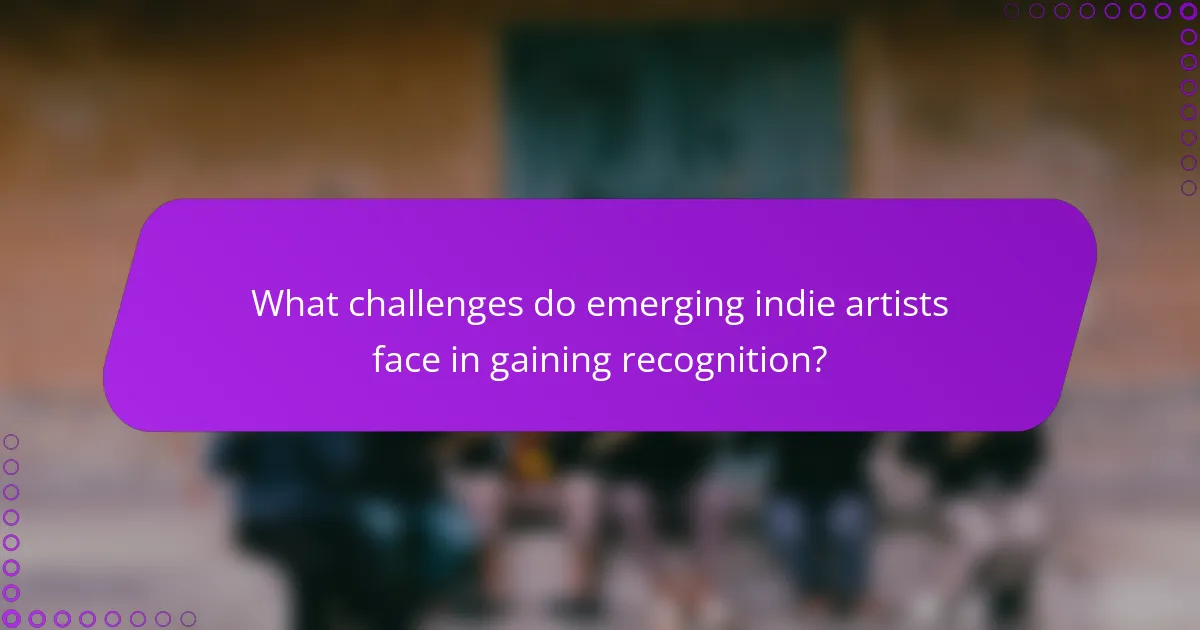
What challenges do emerging indie artists face in gaining recognition?
Emerging indie artists face significant challenges in gaining recognition, including limited marketing resources, competition with established artists, and difficulties in accessing mainstream media. These factors hinder their visibility and audience reach.
Additionally, many indie artists struggle with the digital landscape, where algorithm-driven platforms favor established names. This creates barriers for new talent trying to break through.
Another challenge is the financial burden of producing quality music and promoting it effectively. Without sufficient funding, artists may compromise on production quality, impacting their appeal.
Lastly, the constant need for self-promotion can detract from the creative process, leaving artists to balance artistry with marketing efforts.
How does funding and financial support impact their careers?
Funding and financial support significantly enhance the careers of emerging indie artists by providing resources for production, marketing, and distribution. Financial backing allows artists to invest in high-quality recordings, promotional efforts, and live performances, which are vital for gaining recognition.
Moreover, access to funding can facilitate collaborations with established artists, expanding their network and audience reach. A study indicated that artists receiving financial support are more likely to achieve critical acclaim and commercial success. This support can come from grants, sponsorships, or crowdfunding, each contributing to an artist’s ability to innovate and grow their brand.
In summary, financial support not only alleviates the burden of production costs but also opens doors to opportunities that can elevate an indie artist’s career trajectory.
What barriers exist in terms of industry access and networking?
Emerging indie artists face significant barriers in industry access and networking. Limited connections with established professionals hinder opportunities for collaboration and exposure. Financial constraints often restrict participation in industry events, further isolating these artists. Additionally, the lack of mentorship programs contributes to difficulties in navigating the music landscape. Overall, these challenges impede the growth and recognition of indie talent.
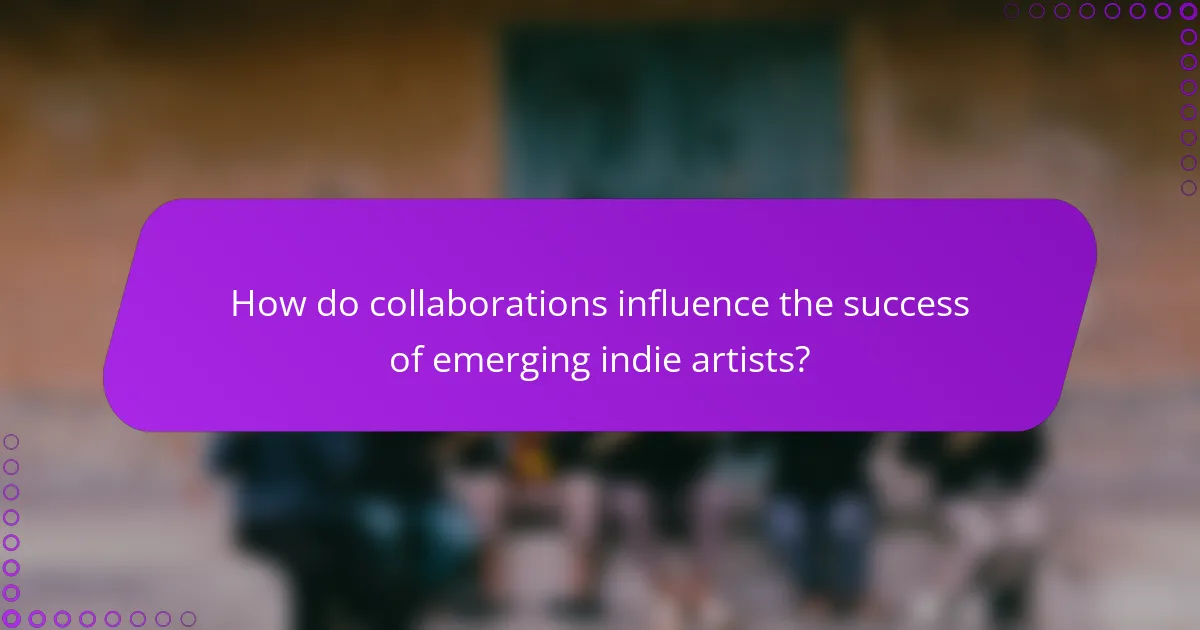
How do collaborations influence the success of emerging indie artists?
Collaborations significantly enhance the success of emerging indie artists by expanding their reach and influence. Working with established artists can introduce them to new audiences, while collaborations within their genre can foster creativity and innovation.
Collaborations can lead to increased visibility through shared fan bases. For instance, a partnership with a well-known artist may result in more streams and downloads, elevating the indie artist’s profile.
Moreover, collaborations often provide networking opportunities, connecting indie artists with industry professionals. This can lead to future projects, tours, or record deals, further solidifying their place in the music scene.
Finally, unique collaborations can differentiate an indie artist’s sound, helping them stand out in a crowded market. This distinctiveness can attract media attention and critical acclaim, essential for long-term success.
Which genres benefit most from cross-genre collaborations?
Genres that benefit most from cross-genre collaborations include pop, hip-hop, and electronic music. These genres thrive on blending diverse influences, attracting wider audiences. For example, pop artists often collaborate with hip-hop musicians to create chart-topping hits. Similarly, electronic music frequently incorporates elements from rock and jazz, enhancing creativity and innovation. This fusion leads to unique sounds, expanding the recognition of emerging indie artists and their styles.
What are the advantages of collaborating with established artists?
Collaborating with established artists offers emerging indie artists increased visibility, access to wider audiences, and enhanced credibility. These partnerships can lead to greater recognition and opportunities within the music industry. Additionally, established artists can provide valuable mentorship and guidance, helping indie artists refine their craft and navigate the complexities of the music business.
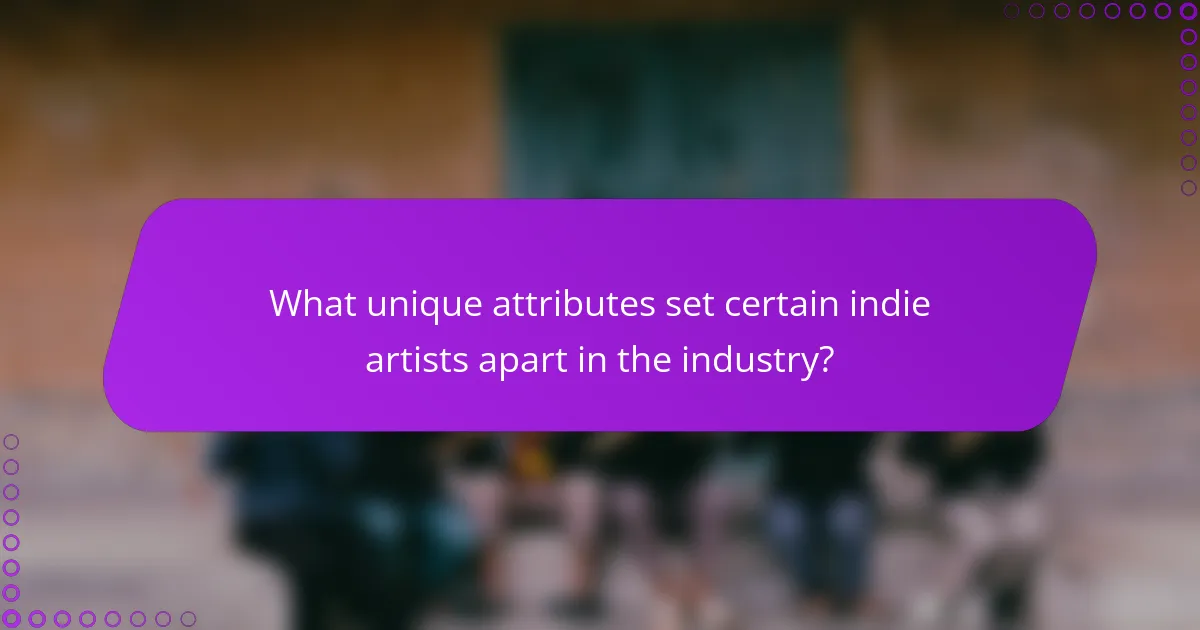
What unique attributes set certain indie artists apart in the industry?
Unique attributes that set certain indie artists apart include their distinctive sound, innovative storytelling, and grassroots marketing strategies. Many indie artists embrace genre-blending, creating fresh musical experiences. Their authenticity and personal narratives resonate deeply with audiences, often leading to loyal fanbases. Additionally, some artists leverage social media effectively, fostering direct connections with listeners. These traits contribute to their recognition and success in a competitive industry.
How do personal branding and marketing strategies differ among artists?
Personal branding and marketing strategies for emerging indie artists differ primarily in their focus and execution. Artists often prioritize authenticity in personal branding, showcasing their unique styles and influences. In contrast, marketing strategies may involve targeted outreach and digital promotion to reach wider audiences.
Emerging indie artists typically emphasize storytelling in their branding, allowing fans to connect emotionally. Marketing strategies, however, often leverage social media analytics to identify trends and optimize engagement.
The root attribute of personal branding is the artist’s identity, while unique attributes may include specific artistic influences or themes. Rare attributes like collaborations with other artists can enhance visibility but are less common.
Overall, successful indie artists balance personal branding and marketing to foster recognition while remaining true to their artistic vision.
What rare musical elements or themes have gained attention?
Rare musical elements gaining attention among emerging indie artists include unconventional time signatures, unique instrumentation, and thematic explorations of mental health. These artists often blend genres, incorporating elements from folk, electronic, and experimental music. For instance, the use of non-traditional instruments like the hang drum or synthesizers adds a distinctive sound. Additionally, lyrical themes that address personal struggles resonate with listeners, creating deeper connections. This innovative approach sets these artists apart in the competitive music landscape.
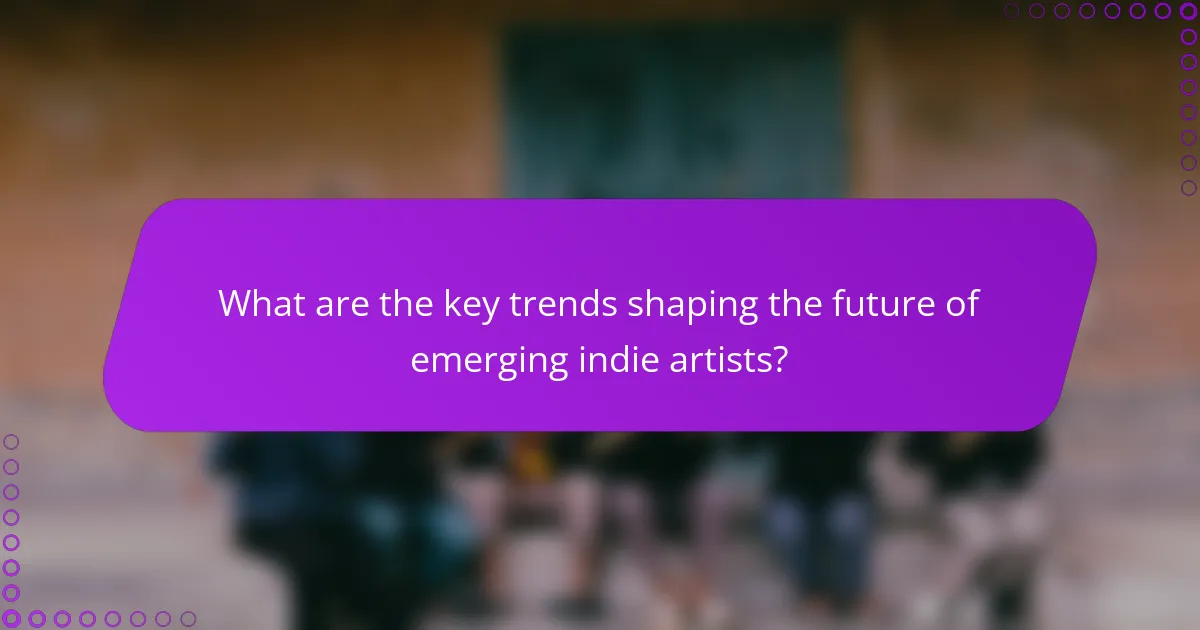
What are the key trends shaping the future of emerging indie artists?
Emerging indie artists are increasingly shaped by digital platforms, genre fusion, and community engagement. These trends enhance their visibility and creative expression.
Digital platforms enable artists to reach global audiences without traditional gatekeepers. Social media and streaming services facilitate direct connections with fans, allowing for immediate feedback and support.
Genre fusion is another key trend, as artists blend various musical styles to create unique sounds. This experimentation attracts diverse listeners and fosters innovation within the indie music scene.
Community engagement plays a crucial role in the recognition of emerging artists. Collaborations with local musicians and participation in grassroots movements strengthen their presence and build loyal fanbases.
How is technology transforming music creation and distribution?
Technology is revolutionizing music creation and distribution by providing indie artists with innovative tools and platforms. Digital audio workstations and software enable artists to produce high-quality music from home. Social media and streaming services facilitate direct audience engagement and broader reach.
Emerging indie artists are leveraging these technologies to explore diverse styles and influences, often blending genres in unique ways. The accessibility of distribution channels allows for increased recognition and opportunities for collaboration.
As a result, many indie artists are gaining traction without traditional label support, showcasing their work through platforms like Bandcamp and SoundCloud. This shift empowers artists to maintain creative control and connect with fans globally.
What emerging genres are gaining traction in the indie scene?
Emerging genres in the indie scene include bedroom pop, lo-fi hip hop, and synthwave. These styles reflect personal narratives and diverse influences, gaining popularity through platforms like TikTok and Bandcamp. Bedroom pop emphasizes intimate production, while lo-fi hip hop blends chill beats with nostalgic samples. Synthwave revives 1980s aesthetics, appealing to retro enthusiasts. Each genre showcases unique attributes that resonate with audiences seeking authenticity and innovation.
What best practices should emerging indie artists follow for success?
Emerging indie artists should focus on authenticity, networking, and consistent content creation for success. Authenticity builds a loyal fan base, while networking opens opportunities for collaboration and exposure. Consistent content keeps audiences engaged and expands reach.
Additionally, leveraging social media platforms for promotion and engaging with followers enhances visibility. Understanding music distribution channels can streamline access to wider audiences. Developing a unique sound and brand identity differentiates artists in a competitive market.
